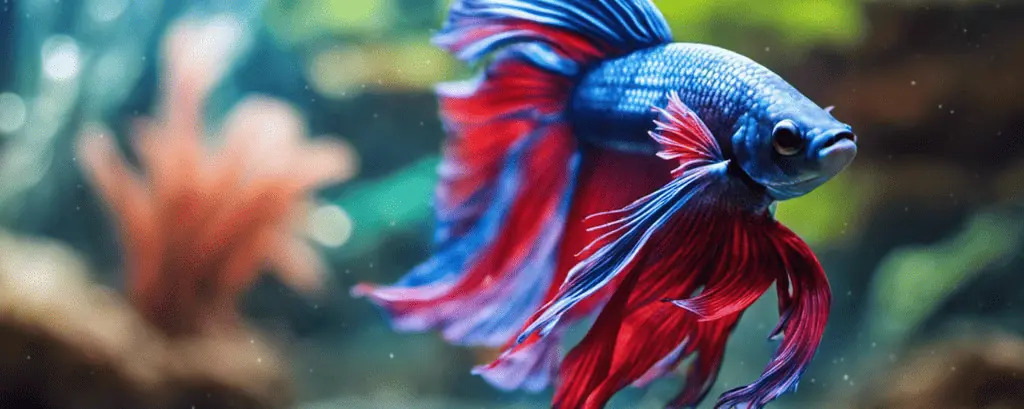Your pet betta fish is probably a tough little critter.
It should be pretty healthy if you’re maintaining its aquarium and feeding it well.
Still, your betta fish will fall ill sometimes, despite your best efforts.
One of the more common illnesses is hemorrhagic septicemia in betta fish, and it’s a problem if left untreated.
We’ll help you with our guide to causes, prevention, and cures below.

Table of Contents
2 Kinds of Hemorrhagic Septicemia In Betta Fish

There are two kinds of HS in fish: viral and bacterial.
The piscine novirhabdovirus causes Viral HS.
This virus was first discovered in the wild in Europe in the 1930s, then found in the United States in 2006.
The virus gets in the water via waste or reproductive fluids. It infects gill tissue, then blood vessels and internal organs.
If a fish community becomes infected, it can lead to a cycle of fish die-offs. Surviving fish will develop temporary immunity.
When the immunity wears off, they get sick again and transmit it, then more fish die. This cycle of fish kills endangers entire fish populations.
Bacterial fish diseases also cause HS. This means some bacterial fish infections cause bleeding (hemorrhaging) and blood poisoning (septicemia or sepsis).
Your pet fish’s blood vessels will weaken. This causes hemorrhaging in the skin, muscles, and internal organs.
If you suspect your betta is ill, remove them from a community tank immediately.
Put the infected fish in a hospital tank to protect tank mates from the illness.
This also protects your sick pet from being picked on by its tank mates.
Symptoms of Hemorrhagic Septicemia in Betta Fish

Early identification of HS might save your fish’s life.
There is no “cure” per se for HS, but early treatment can help your fish recover to normal health.
Common physical signs are:
- Red streaks on fins and body under the scales
- Reddish, bruised look to eyes, gills, skin, and fins
- Ulcers
- Open wounds which are discolored, gray, black, or fuzzy
- Popeye – the bulging of one or both eyes.
- Color loss – a first sign your pet is feeling poorly
- Hemorrhages in veins, muscles, or organs
- Dropsy – severe organ failure, swelling, and a pinecone appearance of scales
Behavioral symptoms are:
- Lethargy
- Loss of appetite
- Droopiness
- Clamped fins
- Gasping for air
- Lying at the bottom of the tank or hiding
Long-term Effects of Hemorrhagic Septicemia

As the condition progresses, more damage is done to the fish, leading to death.
A fish may recover from damage to its veins, scales, and even flesh, but organ damage is permanent.
Infections leading to HS can recur. Early, comprehensive treatment is very important.
When in doubt, consult a vet who specializes in fish.
It’s better to start this relationship ahead of time too. You don’t want to scramble to find one when your pet is sick!
What Causes Hemorrhagic Septicemia?

The hemorrhagic septicemia virus is not the only cause of HS. Bacterial infections also cause HS. Septicemia can occur as a secondary infection to other illnesses.
Infection can come from live food.
Getting food from somewhere outside, such as a pond or river, is risky. It is better to feed your betta frozen foods than wild foods.
Always make sure your betta’s food comes from a reputable source.
Aquarium snails can carry the deadly fish virus causing VHS.
They also carry bacteria. An NIH study identified sixteen different bacteria on the snails studied. Not all bacteria are harmful, of course.
You must weigh the potential for a disease against the benefits of having a snail in your tank. All should be well if your fish is healthy and doesn’t become stressed.
Live plants are potential disease vectors as well.
You may minimize the risk by using a hydrogen peroxide rinse before planting. The procedure for cleaning your plants is as follows:
- Clean and rinse plants with normal tap water
- Mix 2-3 ml 3% hydrogen peroxide with 1 gallon of water
- Dip the plants in this solution for 5 minutes at the most.
- Rinse plants well in tap water
- Treat the plants with water conditioner, then rinse again
Harmful bacteria or viruses can enter your fish tank via equipment.
This means magnetic tank scrubbers, buckets, vacuum cleaners, tubing, filter materials, and nets. Anything coming in contact with a sick fish or contaminated water is dangerous.
Make sure you wash your hands, as contamination can travel in water droplets on your hands or arms.
Fin rot, which is caused by bacteria, can cause HS.
Stress can lead to infection. Fish become stressed by many things. Poor water quality and lax tank maintenance are common.
Ideal Water Parameters for a Betta Fish Tank Include the following:
- Temperature: 78-80° degrees Fahrenheit (25.5-27° C)
- pH: 6.5-7.5
- Ammonia and Nitrite: 0 ppm
- Nitrate: < 40 ppm
- gH: 3-4 dGH (50-66.7 ppm)
- kH: 3-5 dKH (53.6-89.4 ppm)
- Minimum Tank Size: 5 Gallons
Your fish requires its water to be clean and within a certain pH level.
Bettas do well with a neutral pH of 6.5-7.0.
Excessive or rapid temperature changes are also stressful. Be careful with water changes.
Keep your betta’s tank within 78-80° degrees Fahrenheit (27° C).
Keep nitrates and nitrites balanced and prevent ammonia buildup from waste products.
This helps prevent illness. Ammonia spikes are very stressful for fish.
The body needs to be well-nourished to fight off infection. Poor nutrition leads to stress response and illness.
Excessive handling is very stressful for your fish. This leads to increased vulnerability to illness.
How can I prevent hemorrhagic septicemia in my betta fish?

Maintain good water quality and keep a clean tank to prevent disease in bettas. Make regular water changes and remove waste buildup.
Clean the substrate in the tank to remove debris and waste. Ammonia spikes are very stressful for fish.
Your betta should have a varied diet. Possible foods are betta flakes or pellets with ample crude protein.
Frozen whole foods, freeze-dried foods, or the occasional live food are also good. Mosquito larvae, brine shrimp, and bloodworms are live foods.
They should come from a reputable source. Don’t just dump the live food in the tank with the water it came in. Do not feed the pet food you get from outside.
This will help reduce your risk of contagion. Some fish keepers even have their own brine shrimp nurseries to feed to their bettas.
A well-nourished fish will be more resistant to bacterial diseases.
Do not overfeed your betta. Overfeeding leads to problems like bloating and swim bladder disorder.
It also dirties the water with uneaten fish food.
Keep your betta’s tank clean and do not handle your pet too much. Being handled is very stressful for fish.
Conduct regular check-ups of the tank to make sure the filter, pump, and so on are all working. Check your fish to make sure it is healthy with no signs of disease.
A betta needs at least 5 gallons of water to exercise.
Too small of a tank will shorten its lifespan.
Avoid sharp edges on the tank’s objects and any rusty items. Painted objects risk flaking paint in the water.
Natural items such as seashells, coral or sand might change the water’s pH and carry contagion.
A healthy betta has bright colors, flowing fins, is full of energy, and eats well.
If any of these change, your fish might need help.
Treating Hemorrhagic Septicemia in Betta Fish

The best treatment for HS and more common fish diseases is, of course, prevention.
Otherwise, it’s a race against the clock. Isolate your sick fish in a quarantine tank first.
Use a combination of wide-spectrum antibiotics to treat both gram-positive and gram-negative bacteria.
Use medicated food rather than medication in the water.
Oral medication is more effective if your fish is eating well. If your betta is not eating well, then water-soluble medication is your other option.
Also, a salt bath may be effective in helping your betta heal.
Salt helps fight bacteria and parasites.
Using a container holding at least 1 gallon, add 4 TBS of aquarium salt.
Add 1 gallon of aquarium water. Swirl the mixture to dissolve the salt.
Place the fish in the salt solution for 5 to 30 minutes.
At any time, if your fish looks distressed, put it back in its tank.
Common Questions About Hemorrhagic Septicemia

Is hemorrhagic septicemia contagious to other fish in my tank?
Viral Hemorrhagic Septicemia is highly contagious and deadly. HS from bacterial infection is not contagious, although the bacterial infection may be.
Keep sick fish separated from healthy fish, just in case.
Remember to sterilize anything the sick fish comes into contact with. This is exactly why we always recommend having a smaller quarantine tank ready to set up at a moment’s notice.
It doesn’t have to be the full 5-gallon+ size; a smaller 2.5-gallon one will do. And you never know; you may never even need it! But it’s always better to be over- than under-prepared.
Can stress be a factor in hemorrhagic septicemia in betta fish?
Stress is a critical factor in whether a fish develops HS. As with illnesses in humans, stress is directly linked to the likelihood of your betta catching an illness.
A stressed fish has a weakened immune system and is vulnerable to infection. Many things stress a fish. Make sure your fish has a clean, safe environment.
When it comes to stress, you want to make sure you have the right tank setup and the right kind of tank mates. Just because fish can live in the same water parameters doesn’t mean they will get along!
Check out our complete list of the best betta fish tank mates and avoid this added stress altogether.
How common is hemorrhagic septicemia in betta fish?
Because untreated bacterial infections cause it, HS is fairly common in betta fish. Many infections can lead to HS.
The issue is how many casual betta owners don’t watch their pets closely or provide proper water settings.
This is exactly why we started this site! To inform everyone on what’s needed to provide a good, clean, and safe home for their betta fish.
How can I ensure the health and well-being of my betta fish to prevent hemorrhagic septicemia?
Keep your betta in a clean, healthy, low-stress environment. Feed them a varied diet and do not overfeed or underfeed them.
They only need food in the amount of the size of their eye. Do not handle your fish too much.
The Final Word
Hemorrhagic Septicemia is a serious disease and is often fatal to betta fish. It is important to be aware of the symptoms, causes, and preventions of the disease.
It is possible to save a betta fish with hemorrhagic septicemia if it has not progressed too far.
Proper care and treatment are important.
For more on the care needs of betta fish, check out our complete guide at the link.


